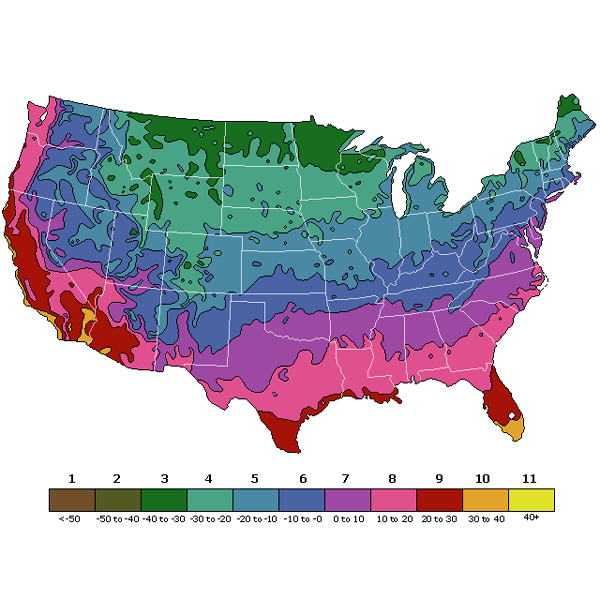
Plant Hardiness Zones

Hardiness Zone for the United States, 2012 showing Average Annual Lows in °F.
The USDA has an interactive map which is a useful resource for pinpointing your own hardiness zone. It can be found here.
Plant Hardiness Zones are wide geographical areas of common climatic conditions. They refer to how cold a plant can tolerate. For example, a plant that is described as "hardy to Zone 6" means that the plant can withstand a minimum temperature of -10°F( -1°C). A more resilient or hardier plant that is "hardy to Zone 9" can tolerate a minimum temperature of 20°F ( -7°C). This plant may likely handle occasional short periods of icy weather. Zones were developed by the United States by the Department of Agriculture (USDA), and updated annually.
| Fahrenheit | Zone | Climate | Celsius |
| Below -50 | Zone 1 | Frigid | Below-46 |
| -50 to -40 | Zone 2 | Frigid | -46 to -40 |
| -40 to -30 | Zone 3 | Cool Temperate | -40 to -34 |
| -30 to -20 | Zone 4 | Cool Temperate | -34 to -29 |
| -20 to -10 | Zone 5 | Temperate | -29 to -23 |
| -10 to 0 | Zone 6 | Temperate | -23 t0 -18 |
| 0 to 10 | Zone 7 | Warm Temperate | -18 to -12 |
| 10 to 20 | Zone 8 | Warm Temperate | -12 to -7 |
| 20 to 30 | Zone 9 | Semi-tropical | -7 To -1 |
| 30 to 40 | Zone 10 | Semi-tropical | -1 to 4 |
| 40 to 50 | Zone 11 | Tropical | Above 4 |
Carnivorous Plants are native to a wide variety of climates and Plant Hardiness Zones. Tropicals are from Zone 11 and above, where winter temperatures are typically above 40°F (4°C). The Nepenthes are in this group as are some sundews, butterworts, and bladderworts. Semi-tropicals are Zones 10-9. Warm Temperates are from Zones 8-6. Cool Temperates are from Zones 5-3, etc.
Hardiness Zones information helps in the selection of plants. Keep in mind that humidity, light, soil, and other conditions can affect the "hardiness" of individual plants. If your intent is to grow indoors than most plants from Zone 8 or higher will do fine. Plants from Zones 5-7 would need some winter cooling off, if grown indoors. Plants from Zones 4 or lower would definitely need some time (about 90 days) in freezing temperatures, as in your freezer (cleaned and in plastic bags of course). If you will be growing outdoors, find out your Zone from the map and select plants from your Zone. You can extend your Zone by 2 above or below your area if you provide winter protection. It is always a good idea to provide protection in extreme summer (shade) and winter (mulch) outdoor growing conditions.
Hardiness Zone information is provided on the plant description pages. It lists two ranges. The first is the Zone Range with typical winter care in those Zones. The second Zone Range (in parenthesis) shows how the growing can be extended with special care during the heat of summer, with water and shade, and in the deep of Winter with mulching. For example: the Venus Flytrap is listed as Zones: 6-9 (5-11), will grow fine in Zones 6, 7, 8, and 9, but will need some protection in Summer/Winter if grown in Zone 5 and/or Zones 10 and 11. Plants may be endemic (native) to one Zone, but can grow beyond their native Zones when given good growing conditions.



